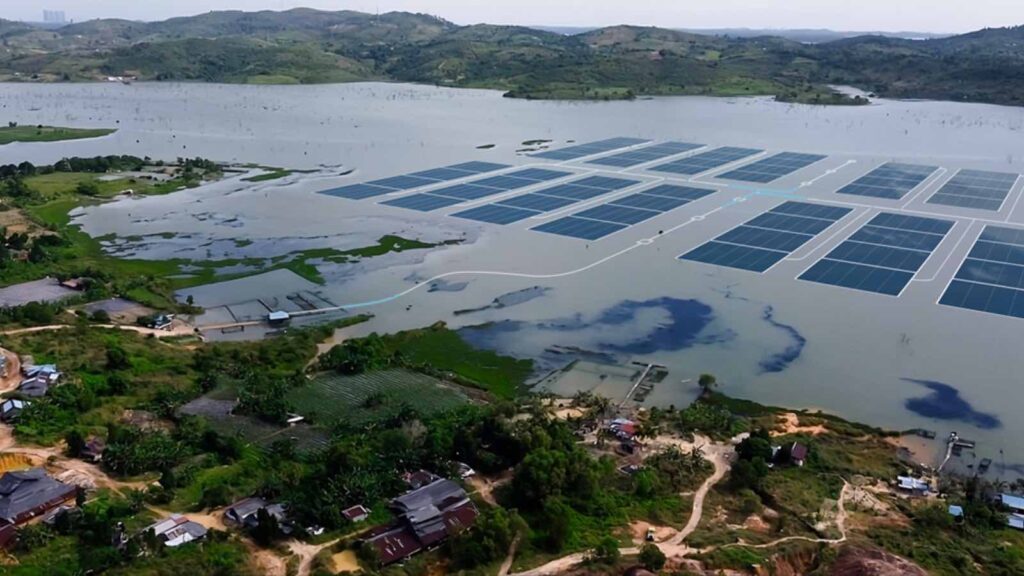Indonesia’s floating solar plant in Batam, The Tembesi, developed in partnership with PLN Nusantara Power and PT TBS Energi Utama, will be located on the 864-hectare Tembesi Reservoir in Batam.
Indonesia is making significant strides in its transition to renewable energy with the construction of a new floating solar power plant (PLTS) in Batam, Riau Islands. Following the success of the Cirata Floating Solar Plant, this project is another pivotal effort by the government to reduce reliance on fossil fuels and move closer to its ambitious goal of Net Zero Emissions (NZE) by 2060.
The Tembesi Floating Solar Power Plant, developed in partnership with PLN Nusantara Power and PT TBS Energi Utama, will be located on the 864-hectare Tembesi Reservoir in Batam. This project marks an important milestone in Indonesia’s renewable energy journey, signaling the government’s growing commitment to sustainable power generation.
RELEVANT SUSTAINABLE GOALS



The Tembesi Floating Solar Plant: Second Largest in Indonesia
Once completed, the Tembesi Floating Solar Plant will be Indonesia’s second-largest floating solar facility, following the Cirata project. This 46 MWp plant is set to play a crucial role in Indonesia’s clean energy transition. The plant is expected to be operational by December 2025, with the first phase of construction finishing by the end of 2024.
The Tembesi Floating Solar Plant project is a result of strategic collaboration between PLN Nusantara Power and PT TBS Energi Utama, with PLN holding a 51% stake and TBS Energi owning 49%. This partnership highlights the growing interest from both public and private sectors in sustainable energy investments.
“PLN’s collaboration with PT TBS Energi Utama aligns with our goal of transitioning toward a sustainable energy future,” said Dicky Yordan, CEO of PT TBS Energi Utama. “This project serves as a catalyst for future renewable energy developments in Batam and beyond.”
PT TBS Energi Utama is deeply committed to environmental sustainability, with a wide range of business activities in electricity generation, renewable energy, electric vehicles, and waste management.
A Catalyst for Foreign Investment
The Tembesi Floating Solar Plant is also expected to attract foreign investment to Batam, strengthening the local economy and promoting sustainable energy infrastructure. “The development of renewable power plants is a key pillar in reducing carbon emissions. The Tembesi Floating Solar Plant can serve as a catalyst for foreign investment in Batam and further strengthen the region’s energy infrastructure,” said Hartanto Wibowo, Director of Corporate Planning and Business Development at PT PLN (Persero).
As more foreign investors become interested in Indonesia’s clean energy sector, the country could see a surge in renewable energy projects across the archipelago.
What is a Floating Solar Plant?
A floating solar power plant (PLTS Terapung) consists of solar panels mounted on floating structures over large bodies of water, such as reservoirs or lakes. This innovative concept has several advantages over traditional solar power systems:
- Efficient Land Use: Floating solar plants do not require large land areas, making them ideal for space-constrained regions.
- Cooling Effect: The water beneath the panels helps cool the solar modules, increasing their efficiency and reducing the risk of overheating.
- Water Conservation: Floating solar systems can reduce evaporation from reservoirs, helping conserve water resources.
- Albedo Effect: The reflection of sunlight off the water’s surface helps enhance solar energy absorption, boosting electricity generation.
Challenges in Building Floating Solar Plants
Despite the benefits, floating solar plants come with their own set of challenges:
- High Investment Costs: The upfront investment for floating solar projects is relatively high, requiring substantial capital.
- Technological Development: Developing efficient floating solar plants requires ongoing research and technological advancements.
- Regulatory Hurdles: Clear regulations and policies are essential for promoting renewable energy projects and ensuring smooth implementation.
- Maintenance: Proper care and maintenance are critical to ensuring the long-term sustainability of the floating solar infrastructure.
By overcoming these obstacles, Indonesia can unlock the full potential of floating solar technology and accelerate its renewable energy transition.
The Tembesi Floating Solar Plant is a critical step in Indonesia’s efforts to embrace clean energy and reduce its carbon footprint. With the support of both government and private sectors, Indonesia is on track to become a regional leader in renewable energy, moving closer to its Net Zero Emissions goal by 2060.
Lead image courtesy of PLN Nusantara Renewables




